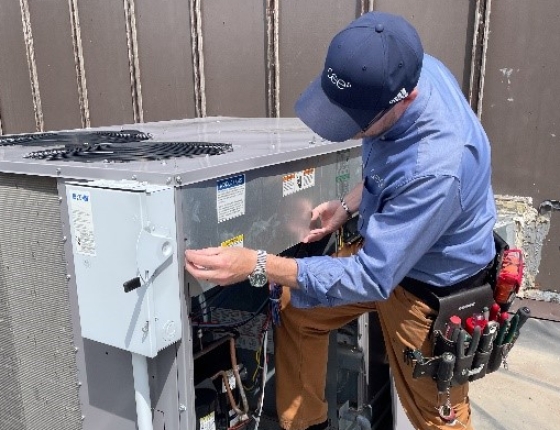Summer weather is here, and heat waves are on the way. If you have an aging rooftop unit (RTU), your HVAC system might already be struggling to keep up with your building's cooling needs. A fault in your building’s HVAC system can lead to disruption and discomfort for employees and customers and carry costly energy bills and repairs. Here are some things you can do now to avoid repairs later and keep your building’s HVAC system running smoothly all summer long.
Before it gets too hot, test it out! Give your HVAC system a trial run when the outside temperatures are still moderate. Temporarily set your thermostat five degrees lower and see if your system can handle the increased load. If it can easily decrease the room temperature during this test, then it should be able to hold your regular desired temperature when a heat wave hits.
Make sure your equipment air filters are clean. Restricted airflow from a dirty filter will cause your blower to work harder, reducing the system's efficiency, and may cause the evaporator coil to freeze up. This will result in inefficient cooling and could shorten the lifespan of multiple components. Replace filters at least quarterly for the best results.
Check that the condenser is clear of debris and not covered. The condenser’s job is to remove heat from indoor spaces to cool your building. Keeping the condenser clean is vital for proper airflow. Over time the condenser can gather leaves, cottonwood, animal nests, sticks, or trash, and reduce efficiency. Be sure to evaluate the unit for anything obvious that should be removed and clean the coils annually.
Check your outside air intake level. Outside air intake system components can malfunction and cause a greater amount of air to be introduced to your building than designed. When outside temps are at extremes, this can result in a system that's unable to sustain the load. Excessive outside air entering your HVAC airstream through a manual damper or economizer damper system will significantly impact the runtime of your furnace and increase your energy costs.
Program your thermostats to setback 5–10 degrees during unoccupied times. When outdoor temperatures are high and air conditioners are working hard, it can be a balancing act between comfort and efficiency. Generally, a setback of as much as 8 degrees during unoccupied hours is recommended. Carefully go through a weekly schedule and program your thermostat to maximize efficiency and comfort needs based on the occupancy hours of your building. Learn more about how thermostat setbacks can help you save energy and lower costs.
Get professional maintenance to keep things clean and in proper working order. To help you beat the heat and keep things in good working order, an HVAC professional can take a closer look at your building’s system to inspect for faults and provide proper maintenance and tune-ups.
Looking for more advice on how to maintain your HVAC system?
CEE's HVAC experts are here to help Xcel Energy commercial customers in Minnesota find energy-saving HVAC solutions tailored to their building and budget. We provide free RTU assessments, free ecobee smart thermostats, and rebates covering up to 60% of project costs.
